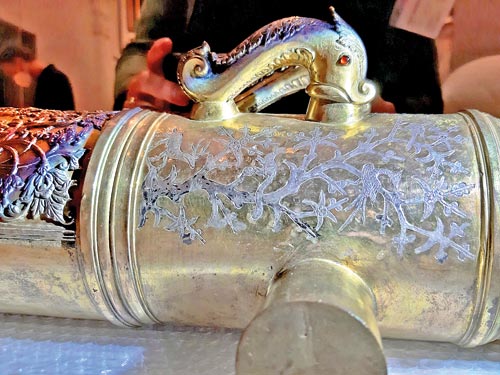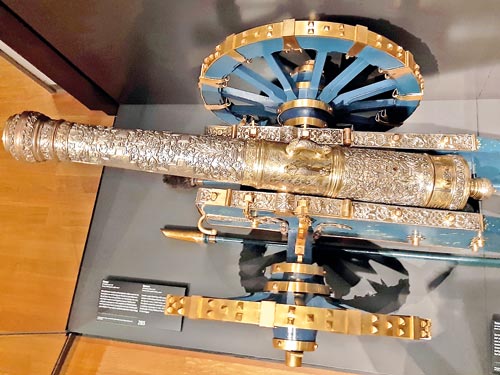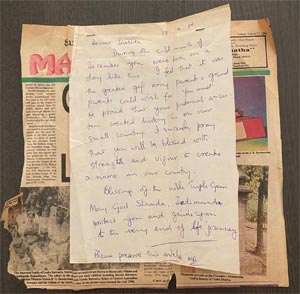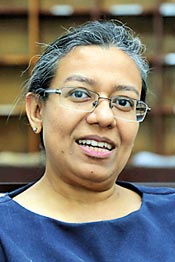Trailing a royal gift and a warrior-ancestor

Detailed carving depicting the 'Eternal Tree' with deer, giant squirrel and birds at the centre of the cannon, with a dolphin-shaped grip. (Pix courtesy Rijksmuseum)
Tales of battles passed down the generations she had heard as a little girl while seated on Ath-amma’s knee and a yellowed and dog-eared paper clipping left behind with a passionate plea in a letter by her Achchi…..all centred round a warrior-ancestor and an exquisite but handy gift to a king.
Then followed a visit to a museum in the west.
“Surreal,” is how Levuke Wasala Mudiyanselage Anekha Ashwini Unambuwe (33) describes the moment when she set eyes on the much-talked-of ‘Levuke cannon’.
It was June 2018 when she and her mother were touring Europe that they stopped by the Rijksmuseum, the national museum of the Netherlands in Amsterdam. It was huge and they looked and looked and found the cannon just before the exit, sharing a cabinet with guns, knives and a medal.
“Beautiful was the cannon,” says Anekha, describing how it was both delicate and intricate, the craftsmanship exquisite. Regal, with a quiet elegance!
Now Anekha is ecstatic because the Dutch authorities have assured the return of the cannon and several other artefacts to their rightful home which is Sri Lanka, more than 250 years after it left this country’s shores.
Before launching into the details of her quest for the return of the cannon, she says that the description at the museum stated: ‘Cannon’, Sri Lanka before 1745…… “Salutes were fired from this cannon to welcome the visitors of the King of Kandy. His symbols were found on the barrel: a sun, a half moon and the Sinhalese lion. The Dutch seized the splendid cannon as booty during a military campaign in 1765. They presented it to Stadholder-Prince William V for his cabinet of rarities in The Hague.”

Anekha Unambuwe
The cannon is 98cm in length (about 3.2ft), with a diameter of 43cm, while the carriage height is 54cm, width is 181cm and depth is 77cm. The material used is bronze, silver, gold, rubies and wood and the technique of production had been casting/inlay (process)/sawing.
Anekha looks back at how her quest for the return of the cannon was sparked by the letter penned by Achchi (her maternal grandmother Doreen Wijesinghe) 26 years ago, addressed to her brother Ineshke who was just nine years old, while she was only 7 at that time. She had found it much later attached to a newspaper clipping with half an article.
Achchi had urged her brother “to be proud that your paternal ancestors created history”, while a younger brother of Anekha’s Ath-amma (paternal grandmother Olga Mallika Ratwatte Unambuwe), Irvin Ratwatte, still lives at Levuke Disawa’s walawwe in Mawanella. The walauwwe has now been inherited by Anekha’s father, Lalith Anuruddha Unambuwe.

Levuke's cannon
The Sunday Observer clipping of February 18, 1996 which blazed ‘Guns of Leuke’ had triggered a yearning in Anekha to glance back into the dim mists of time and also forward as to how Sri Lanka could get its invaluable artefacts back.
“The article by Padma Edirisinghe gave an overview of my ancestors and the lineage/descendants, while also mentioning the change of power from the Sinhalese kings to the Nayakkar kings in the 18th century,” says Anekha, explaining that so many centuries down the line, the Disawe’s name is spelt in different ways in English – Leuke, Lewke and Levuke, the latter being preferred by her family.
Keeping tabs on newspapers, Anekha followed the paper trail: an article here and there and then the visit in 2018 to Amsterdam’s Rijksmuseum, with the sight of the cannon holding her spellbound.
Next she stumbled on a document along with a replica at the J.R. Jayewardene Centre on Dharmapala Mawatha, Colombo 7 in March 2019. It was from Army Headquarters and provided more insight on the cannon with specific reference to the Dutch Governor of then Ceylon, Jan Baron Von Eck taking the cannon as “war booty” sometime between April 1745 and April 1746.

The letter and article that started it all
The tragic family history too came to the fore in this document that King Sri Vikrama Rajasinghe had ordered the execution of Levuke Disawe, who was defeated by the British in the battle of Hanwella along with a poem about the Disawe and an early translation of the inscription on the body of the cannon.
It was then that she wrote to the Sri Lankan President requesting action for the return of the cannon.
Anekha also realized that she was not alone in her quest, when a friend pointed her in the direction of a webinar titled: ‘Exploring Heritage, Sri Lanka-Netherlands Relations’ on October 20, 2022 organised by the Centre for Global Heritage and Development of the Leiden-Delft-Erasmus Universities. She linked up with Prof. Naazima Kamardeen, Chair Professor, Department of Commercial Law, Faculty of Law, University of Colombo, who was speaking on ‘Colonial Cultural Property: Reconciliation Through Conflict?’
It was much before the declaration that the cannon would be returned to Sri Lanka that the Sunday Times met with both Anekha and Naazima
last year to gather information about this artefact.
| A plea to safeguard the cannon | |
| “We need to protect and safeguard the cannon in Sri Lanka,” is the earnest plea of Levuke Disawa’s descendant, Anekha, while being overjoyed at moves to bring it home.Citing just one example, she says that the carriage on which the cannon is placed is of wood and the authorities should ensure that there is temperature control where it is to be stored to prevent humidity causing warping.“Sri Lanka needs to protect its cultural treasures for posterity,” is her plea. |
| Remarkable step in breaking shackles of colonialism | |
 Naazima Kamardeen “The return of the cannon is a remarkable step in breaking the shackles of colonialism,” states Prof. Naazima Kamardeen, Chair Professor, Department of Commercial Law, Faculty of Law, University of Colombo, adding that this affirms Sri Lanka’s status as a sovereign nation. Prof. Kamardeen has been actively engaged in researching the legal background of Sri Lanka’s long-lost heirlooms. |
| The cannon in detail | |
 Ganga Dissanayaka A detailed description of the cannon has been provided by Ethnographer and Art Historian The analysis and conclusions are in the ‘Provenance report regarding the Singaleese kanon of Lewuke’s kannon’ compiled by the Universiteit Leiden of the Netherlands in 2022. Here are a few highlights of the input of Dr. Dissanayaka, along with a historical interpretation of the Sinhala inscription on it.
Meanwhile, Dr. Dissanayaka who has also transcribed and translated the transcription on the cannon anew says that it had been gifted on a day within the period from 14 April 1745 to 14 April 1746. The usage of thethennehe refers to Lewke’s appointment as Disava of the four korales “Thus, between 14 April 1745 and 14 April 1746, the Lewke Disava had the cannon decorated as a gift, yet the inscription does not tell us directly to whom it was gifted,” she states. According to her in the 18th century, different generations from the Lewke family held the post of Disava (governor) of the three and four korales, two provinces in the Kandyan Kingdom that bordered Dutch territories. In the period when the cannon was decorated, Lewke tried to reinforce the Kandyan position vis-à-vis the Dutch, while at the same time improving his own political position in Kandy……he is known to have supported cinnamon peelers in a rebellion against the Dutch. Moreover, he played a crucial role in the renewal of the Buddhist Sangha, by setting up diplomatic contact with Siam and Arakan, through the help of the Dutch. The conclusions drawn are that the cannon was cast in the Dutch Republic, possibly by the Hemony brothers in Amsterdam, or in Batavia. It was probably a gift for (or ordered by) the king of Kandy, and possibly displayed at the palace entrance already prior to 1736…….the rich and elegant silver and gold embellishment has been added as a gift by Lewke Disava to King Srivijaya Rajasinghe sometime between 1745 and 1746, probably to enhance his internal position in the kingdom.
|
Searching for an ideal partner? Find your soul mate on Hitad.lk, Sri Lanka's favourite marriage proposals page. With Hitad.lk matrimonial advertisements you have access to thousands of ads from potential suitors who are looking for someone just like you.


